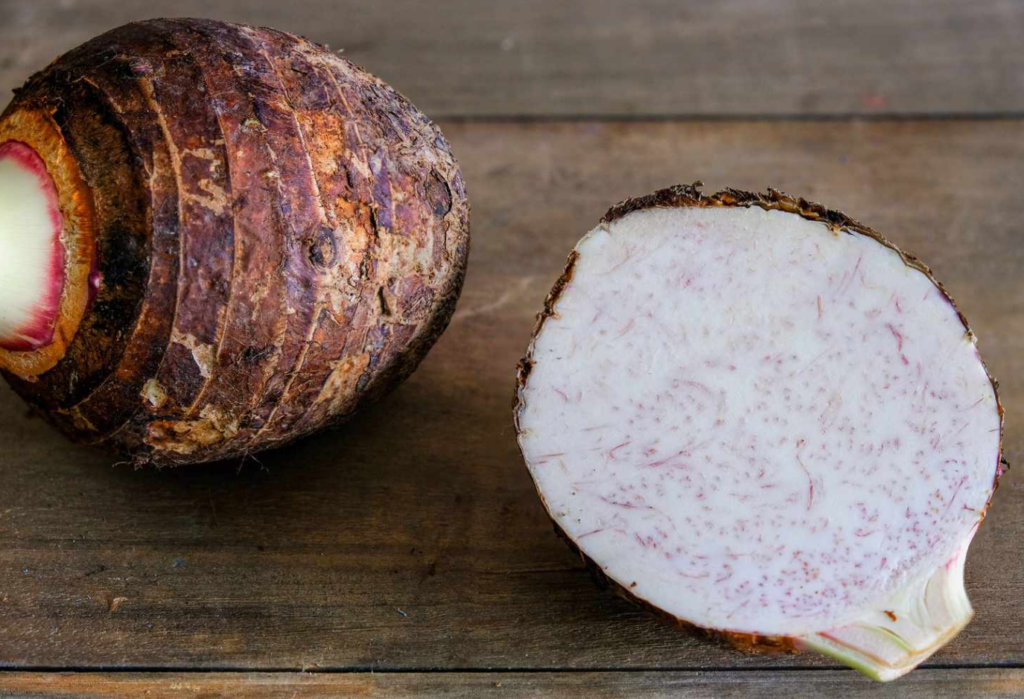Taro ( Colocasia esculenta), with its distinctive heart-shaped leaves, has been a vital food source in tropical and subtropical regions for centuries. Best known for its edible corm or root, taro is celebrated for its rich, starchy texture and impressive nutritional profile. While the corm is the most widely consumed part, taro leaves are also valued in some cultures for their unique health benefits.

Nutritional Profile and Health Benefits of Taro Root
Taro root is renowned for its nutrient density, offering a range of health benefits:
- High Fiber Content: Packed with dietary fiber, taro root promotes healthy digestion, supports gut health, and helps manage satiety—making it beneficial for weight control.
- Vitamin and Mineral-Rich: Taro root provides essential vitamins like vitamin E, B6, and C, alongside minerals such as potassium, magnesium, and manganese, all of which contribute to cardiovascular health and energy production.
- Heart Health Support: Rich in potassium, taro root helps regulate blood pressure, balancing sodium levels to support heart health.
- Sustained Energy: As a source of complex carbohydrates, taro root provides lasting energy, ideal for staying active throughout the day.
- Immune System Boost: Vitamin C in taro root aids immune function, shielding the body against common illnesses and enhancing overall wellness.
- Antioxidant Properties: Taro root contains antioxidants that help fight oxidative stress, supporting skin health and reducing inflammation.
- Blood Sugar Regulation: High in fiber, taro root can help stabilize blood sugar by slowing carbohydrate absorption, which may benefit individuals with diabetes.
- Bone Health: Taro root offers magnesium and calcium, which support bone density and reduce osteoporosis risk.
- Cognitive Support: Vitamin E and antioxidants in taro root may protect brain cells, supporting cognitive health and potentially reducing age-related decline.
- Weight Management: The fiber and slow-digesting carbohydrates in taro root help prolong fullness, aiding in reduced calorie intake for weight management.
Culinary Uses and Preparation

Taro root’s versatility allows it to enhance various dishes:
- Boiled or Steamed: Peel and cook taro corms until tender, then season as a nutritious side dish.
- Mashed Taro: For a healthier alternative to mashed potatoes, mash cooked taro with butter or coconut oil.
- Taro Fries or Chips: Thinly slice the root, season, and bake or fry for a satisfying, crunchy snack.
- Taro in Soups and Stews: Add cubed taro to soups or stews to create a hearty, filling texture.
Safety Note: Always cook taro root thoroughly to neutralize calcium oxalate, which can cause irritation if consumed raw.
Beyond the Root: Taro Leaves and Stems

While the root is the star, taro leaves and stems are also consumed in various cuisines. Properly cooked taro leaves are used in dishes like soups and stews, adding nutritional value with compounds such as beta-carotene, which supports vision health. Like the root, the leaves should be cooked thoroughly to remove any potentially irritating substances.

Taro (Colocasia esculenta) remains a dietary staple in many parts of the world, thanks to its nutritional benefits and culinary versatility. The root’s high nutrient content makes it a valuable addition to meals, while the leaves offer additional health benefits when prepared properly. Incorporating taro into your diet can elevate both flavor and nutrition—just ensure each part of the plant is safely prepared.


